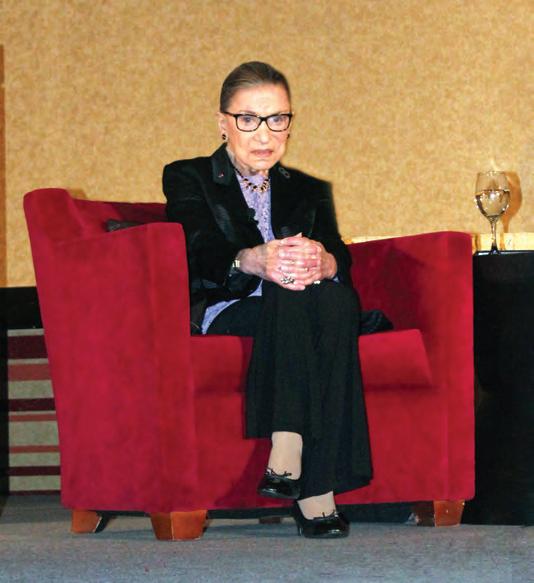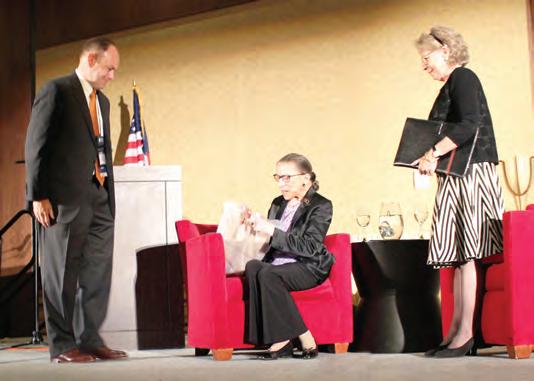
5 minute read
For Justice Ruth Bader Ginsburg, New Mexican at Heart, by Roberta Cooper Ramo
For Justice Ruth Bader Ginsburg, New Mexican at Heart.
By Roberta Cooper Ramo
So much has been written and spoken about the life and the cataclysmic impact of the death of Justice Ruth Bader Ginsburg, that it is fair to wonder what a New Mexico lawyer might have to add. What I know is that New Mexicans all, and especially lawyers and judges mourn her as one of our own, because we saw her love of our State, our people, Our Santa Fe Opera, our values and our skies.
For decades, Justice Ginsburg came to our miraculously beautiful state to refresh and expand her visual, musical and cultural horizons. One of her admirable qualities, was her willingness, with pleasure, to interrupt her vacation days to read to children, speak to groups of all kinds and in one of her last visits here to speak at the State Bar of New Mexico Annual Meeting. Under the leadership of Brent Moore, then President, the State Bar moved its Annual Meeting to August to hear her. To the more than 1000 lawyers, judges, law school professors and their families, especially their daughters, moving that meeting gave them a chance to see one of the most memorable legal icons in the history of the American Democracy. It turned out that while seeing her and hearing her in person was remarkable in every way, the lesson that she taught before she began her interview was a lesson deeply important for this very moment in our nation’s fraught history; when we seem to be teetering toward losing our democratic experiment. Justice Ginsburg taught this lesson by asking to speak fist about the death of her friend and colleague at the Court, Justice Scalia. As she walked onto the stage that day, the entire audience rose to their feet to cheer her. Ths was not just the applause of respect and awe that an Associate Justice of the United States Supreme Court might expect when far from DC. It was a flod of genuine affection and gratitude for what her life at the law had wrought. But rather than take that moment of celebration of her as a personal compliment, she wanted to use our attention to remember her friend Justice Scalia and explain how two people, a man and a women who came, sometimes it seemed, from different planets, could have such deep respect and affection for one another. At the same time, it was a primer in how the Supreme Court works and why dissents matter, whether she was the one in dissent to a Scalia Opinion or he in dissent, as in the Virginia Military Institute case to her majority opinion. She also explained about judicial compromise. I wish today, that I could channel her views to those who did not have the luck to be her colleague at that most consequential of American institutions for long enough or at all. I saw in Chief Justice Robert’s tear filled eyes as she lay In State in the Court, grief not just for her person, but for her presence in that room of 9.
Perhaps some part of her impact was because she knew what it was like to be discriminated against. Or to be diminished as she tried to do her work. She once said that she had three strikes against her as she started out in law school and then after her graduation; she was a woman, a Jew and married with a child. How could such a person think that she might have a career at the law, filled with men? She could, because she simply refused to let the narrow-minded views of those at the time keep her from doing her brilliant work. She was a warrior for the rights of women, as an advocate and later as a judge. In being that advocate for women, she was also an advocate trying to demolish a legal insistence on gender stereotypes. Later she sought to bring down legal barriers for people who only wanted the right to love and marry whom they wished, who were poor, under represented or the objects of racial or ethnic discrimination. Being all three of those things that she found as barriers to be knocked down, my life was made possible by her work and her example.
She came here, to see her friends Judge Seth and his wife and daughters and fell in love with the Santa Fe Opera and New Mexico. Over the years, she made many friends; lawyers like me or young opera singers or judges she came to know here and respect. Her view of our deep appreciation for the lives and cultures of those different from ourselves validated her efforts to make that so for every American under the law.
So now, it is our time as lawyers, judges, and teachers of law to stand together in her place. Each of us must now, with her quiet civility and determination, fiht for liberty for all in the law and in our courts and our offices We must hear and argue out our differences and fid compromises to move our state forward one hard step after the other, but always as friends at the State Bar.
Every time I was lucky enough to talk to Justice Ginsburg whether in person or over the phone, (I once confessed to her that I stood up every time she called, which made her laugh, but I could not help it.) she would ask “How are my New Mexico Skies?” Now she is in them, looking down I feel sure to see how we will honor her life with our actions. We are New Mexicans; we will not let her down. Justice Ruth Bader Ginsburg, keynote speaker at the 2016 State Bar of New Mexico Annual Meeting


2016 President J. Brent Moore and Roberta Cooper Ramo with Justice Ginsburg
Roberta Cooper Ramo is a shareholder of Modrall Sperling. She was the first woman to be elected President of the American Bar Association and was also the first woman to be President of The American Law Institute. Roberta was awarded The ABA Medal and was elected into The American Academy of Arts and Sciences. She serves as Chair of the board of ThinkNewMexico and on the Board of The Santa Fe Opera and Albuquerque Economic Development. She is a member of the American College of Trust and Estate Counsel and on panels of The American Arbitration Association. She has also served as the President of the Board of Regents of UNM.






